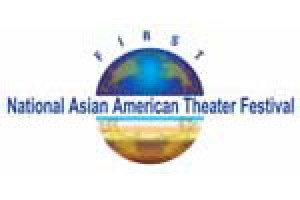
in The House of Bernarda Alba
(© Bruce Johnson)
The ranks of summer theater festivals has just increased by one, as the first National Asian American Theater Festival (NAATF) performs on a variety of New York City stages June 11-24.
The event kicks off with a gala benefit at The Public Theater featuring excerpts of Asian American plays that have been performed there, including works by David Henry Hwang, Jessica Hagedorn, and others. The festival itself includes shows as diverse as the immigrant drama The Romance of Magno Rubio; Ramble-Ations: A One D’Lo Show which fuses elements of gay culture, Hinduism, and hip-hop; and Parang Sabil, a multimedia performance about the U.S. military occupation in the Philippines presented by the Massachusetts-based New World Theater and the NYC-based indigenous Filipino dance troupe Kinding Sindaw.
“Our concern for the first festival was that it be as diverse as possible in terms of style, demographic, culture, and generations,” says Mia Katigbak, the artistic director of the National Asian American Theatre Company (NAATCO), which is one of the three organizations (along with Pan Asian Repertory Theatre and Ma-Yi Theater Company) that forms NAATF’s executive committee.
The seeds for the festival were planted as far back as 2003, when a number of Asian American companies participated in a TCG forum for theaters of color. Last year, an Asian American theater conference was held in Los Angeles, which provided an even greater opportunity for artists from across the country to exchange ideas. “One thing that really surprised me in a pleasant way at the conference was sheer numbers,” says Philip W. Chung, the co-artistic director of the L.A.-based Lodestone Theatre Ensemble. “When I first started my career 10 years ago, I pretty much knew who everyone was, but now there’s so many new groups and shows popping up all over the place that I can’t keep track anymore.”
Katigbak began NAATCO in 1989 to give Asian American actors the opportunity to get cast in roles for which they wouldn’t normally be considered — such as the canon of Western classics. “I wanted to develop a very large pool of acting talent so that it became undeniable that we could do this stuff,” she states. “The bottom line was to question people’s stereotypical perceptions about Asian Americans.”

and Charles Kim in TeleMongol
(© Shane Sato)
Indeed, NAATCO has revived two of its most acclaimed shows for the festival, neither of which was originally written for Asian Americans. The House of Bernarda Alba, which has been adapted and directed by Chay Yew, features Ching Valdes Aran in the title role, with Katigbak as her mother, Maria Josefa. Meanwhile, its version of William Finn’s musical Falsettoland stars such respected performers as Christine Toy Johnson, Francis Jue, Jason Ma, and Manu Narayan. “I wanted to present two very different things, both realized by all-Asian American casts” says Katigbak. “There are several cultures onstage — Jewish, gay, Spanish — interweaving beautifully.”
For his part, Chung instigated a collaboration between four of L.A.’s Asian American companies — 18 Mighty Mountain Warriors, Cold Tofu, Lodestone, and OPM — entitled TeleMongol, which is set at a fictional Asian American television station, with the various sketches included within it representing the network’s programming.
“Even though our four groups are very different, we have a similar sensibility,” says Chung. “Writers from each group would meet regularly and brainstorm ideas together, and then people would go off and write either by themselves or in partnership with someone else, then bring it back in and we’d all go over it. In the end, the play is a comment on Asian American pop culture or lack thereof.”
Mu Performing Arts, based in Minneapolis, has become one of the Midwest’s foremost pan-Asian performing arts organizations over the past 15 years. “One of the strengths of Mu is its commitment to developing and nurturing artists, as well as new work,” says Jennifer Weir, who is directing Mu’s entry, Aurorae Khoo’s Happy Valley, which world premiered in 2005. “It’s such a great, smart script,” states Weir. “The play takes place the year before the handover of Hong Kong from the British to the Chinese and focuses on one family’s experience with that transition. I like how the playwright balances the family drama, grounded in emotion, with this whole other world where the characters represent the greater nations at play at this time in history.”
Asian American artists have made considerable strides in the last several decades, so much so that the necessity for the continued existence of ethnic-specific theater companies has even been called into question. However, Weir believes that their time has not yet passed. “There’s a unique perspective in having Asian Americans working in and on theater,” she says. “Even when other theater companies do an Asian American play, or what they think would serve that community, they often miss the boat — really miss it, in ways that I find shocking.”
Katigbak concurs. “It’s still prevalent that people make assumptions about who you are because of how you look,” she states. “By working in Asian American theater, artists become invested in the project of making people understand that the limitations that are imposed on us have to be shot apart.”








